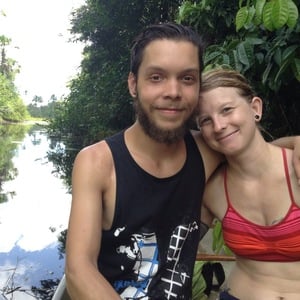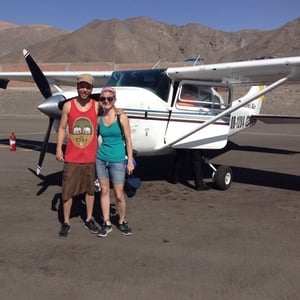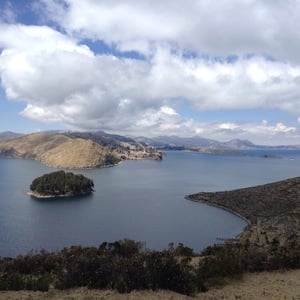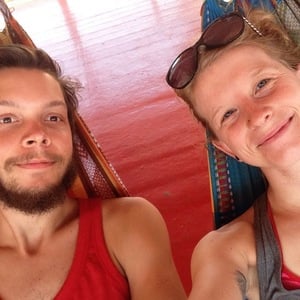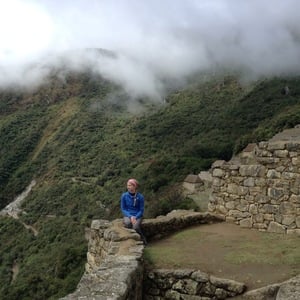Jacob & Hannah
We had our fun the previous night at our homegrown wedding in my parent’s backyard. Hannah and I had spent the past six months folding a thousand origami flowers, making seed bomb party favors (balls of wildflowers in clay that can assault any pitiable, flowerless corner of a town) and figuring out whether we were catering our beloved friends and family’s visit with Falafel food trucks or Chipotle.
We landed on Chipotle.
The entire day was entirely of our making as well as the night and went off better than we could have imagined, complete with 100 of our close family members and friends. We hopped in the car with Hannah’s dad to ride from my hometown of Minneapolis, to hers, Milwaukee, where we would depart on our three-month honeymoon in South America.
We slept restlessly the night before on the futon of Hannah’s Dad’s office futon. We woke early in the AM around four to head to the airport. I was nervous, but mostly about our families worries about our trip. We pulled up to the passenger drop-off curb, hugged Hannah’s Dad goodbye and threw on our (at the time) heavy backpacks. Which by backpacking standard, were not heavy – but still contained the items of an over-prepared newlywed couple embarking on a long stay transcontinental backpacking trip. Hannah slept on the floor of the airport with my sweatshirt over her face while I watched the overhead flight ticker hypnotically in a sleepy stupor. I was in no hurry and had no nerves yet as we still had to transfer flights in Atlanta, and then there were still another seven hours of flying across the equator.
Our first night we arrived in Lima, Peru. We were not expecting this transition to go smoothly, and it certainly didn’t. The man that was picking us up from the airport (he was the hostel shuttle driver) hadn’t shown his face yet and we still needed a vaccine for Yellow Fever. We stumbled through incoherent Spanish together at the medical center of the airport after making a couple laps around the whole airport to locate it. We tracked our passports anxiously like rookies as we were separated from the little blue books for the first time. We were taken into a patient room and received our yellow fever vaccinations. Around midnight, our hostel shuttle driver showed up with a sign with our last name on it. After arrival, we crashed hard on the creaky bunk in the cold, strangely tall room we finally made it to.
After three days of touring Lima and all of its markets, catacombs, and police-lined capitol and Plaza De Armas, we headed north to Huacho, where we would be volunteering at an organic farm. This did not happen due to the host backing out on plans. But, we ended up being welcomed in this little town by Hannah being treated like a celebrity because of her fair skin, blonde hair, and blue eyes – and a 16-year-old boy, Victor, giving us a tour – he being one of the only English speakers in the town aside from the schoolchildren who could yell “Hello Mister!” very well. We stayed 3 days here and enjoyed a cultural festival called man of the tattoo, complete with traditional dancing, fire throwing, and of course – Cuy meat (Guinea pig) which turns out to be like a very, very leathery chicken wing.
We decided to revise our trip after a couple months being cut from our plans because of our lack of farm stay. We headed to Lima to catch a transfer bus to Cusco. On the fly we decided to make a stop in Nazca, where we flew the Nazca lines with a friendly Canadian and his French companion. It was a half-hour non-stop roller coaster ride, shifting from pointing one wing at the ground, then the other in figure-eight patterns. I would have paid that much just for the plane ride, let alone seeing the Nazca lines (which were astonishing). We had a good nights rest and the next day we spent 18 hours on a bus shifting back and forth in the middle of the night through the winding mountain passes of the Andes Mountains, listening to a stray water bottle roll from one side of the bus to the other – trying to sleep without rolling out of the seats proved both a difficult and laughable task.
The sun rose, and with a wipe of the hand, through the condensation of the top level of the bus’ front window the Andes opened up to us. Later, Roadwork kept us in one spot for 3 hours in the morning – which gave us the opportunity to take a quick bathe in a nearby mountain river. After that long on a bus, it seemed invaluably refreshing. Our bus later stopped at a family’s house outside a small town where everyone could buy some food or concessions. Hannah and I spent that time wandering around the houses and admiring the scenery of the mountains.
We arrived in Cusco early that evening and enjoyed some Cusquenian cuisine before checking into our hostel. The next day we met Jorge, who we would be volunteering with in Maras – a rural neighboring city an hour outside Cusco. We stayed in his hostel the next two nights, where we met two American girls that gave us great info on how to do Macchu Pichu the inexpensive (and most adventurous) way.
We spent a week at Jorge’s mother’s house, caring for the town’s children between school and farm day’s end. We painted faces, constructed lamps, played football, and took siestas in the garden. After we said goodbye to Jorge and his community, we trekked to Macchu Pichu via collectivo vans packed with twice as many people than was recommended, backpacking along train tracks, and camping for three days with two German comrades. We made our way back to Cusco after summiting Macchu Pichu the less trodden route. We arrived after four hours of riding in a collectivo, and Hannah acted as a crutch for me as we found the nearest hostel and we took a two day break from traveling (after I had contracted some traveler’s sickness, which is both inevitable and frequent).
We were headed south to Bolivia. After stopping in Puno to see Lake Titicaca from the Peruvian side and to enjoy the first of what would be a long streak of meals of only Millanesa de Pollo, we took a bus through Bolivian customs and arrived in Copacabana, where we found a hostel overlooking the beautiful Lake Titicaca.
We spent a day exploring the rural countryside before taking a boat to one of my personal favorite destinations of our journey – Isla Del Sol. We rented a small cabana on the frigid, windy island late in the afternoon after a very steep hike following José up to his home where our cabana was. He bid us good night and left us to enjoy each other’s company (and queso Pringles, and playing with stray cats we let into our cabana). We woke up early in the morning to enjoy the sunrise on the island of the sun. We were not disappointed – the sun rose over the cordillera range of mountains and shot across the dark indigo colored lake like a beam and ignited the island in a yellow and orange haze that was surreal.
That day we hiked to the northern end of the island and back – a 12 mile feat that took the entirety of the daylight and had to be ended with pizza and beer, which, in times of needing motivation – can be chanted. “Pizza. Beer. Pizza. Beer.”
After two days of enjoying the island of the sun, we headed back to Copacabana to hop a bus to La Paz. We knew the least of La Paz out of anywhere in our trip thus far, and didn’t know exactly what to expect. La Paz has a special place in our hearts where strangeness and odd but friendly people belong. We enjoyed eating saltenas for breakfast almost every day, which is a necessity that is hard to deny. We hopped on a bus the next day to Ororu, a small mining town in central Bolivia, and then caught a train to Uyuni, the base town for exploring the largest salt flats in the world, the Salar de Uyuni.
We hired a tour guide and ended up on in a Toyota 4 runner packed with surly Australians, driving through a salt desert in no time. The first oasis we came by had no vacancy, nor did the next 2. We finally found a hostel to take us in after a great effort on the part of our tour guide, Luis. We enjoyed the next 4 days exploring volcanic lakes, fossilized lava beds, gigantic wind-carved rock sculptures, and observing time’s toll on an unreal patch of earth – where oddly, hordes of flamingos congregated and ate volcanically hosted bacteria all day, every day.
We dropped the Australian group off at the border of Chile halfway through our tour. Hannah and I both have been to Chile, technically –after crossing the border to use the desert bathroom – which is sand, on the ground. Luis felt comfortable enough to eat lunch with us after this – and since our Spanish was a bit better after a month of being on the other side of the equator – he told us about how he loves being the dad of a 4 year old daughter he has and had been working touring the salt flats for 6 years.
After returning to Uyuni, a long ride back to La Paz, and a tough political wrestle with the Brazilian Embassy to get our visas, we were on a plane from La Paz to Trinidad, Bolivia to transfer planes to the Bolivian border town Cobija, where we took the fastest taxi ride of our lives to Rio Bronco after lots of “que?” and me speaking my very limited amount of Portuguese, but showing my fluency in shrugging and apologizing.
With a bit of Luck, we ended up at a hostel owned by Sara, a very friendly Brazilian (who also spoke Spanish!). They showed us the markets in Rio Bronco and the festivities to enjoy. They also learned us on how to enjoy the midday break of the region – 11 am to 3 pm in Brazil and Northward countries in South America all enjoy this leisure time in their day. It is simply too hot to do anything, let alone work – so everyone takes a siesta and a cerveja and kicks it for 4 hours until the sun lets up.
We took a bus to Puerto Velho, where we would be hammock-sleeping on a cargo boat down the Rio Negro and Amazon River to Belem and coastal Brazil with hammocks we purchased in the Bolivian street markets. We enjoyed our time on the onion boat – Patricio sharing sandwiches and showing us neighboring towns while we wait for our cargo boat to be loaded with one million metric tons of onions - to sitting around with a bunch of 19 year old Brazilian guys, passing a makeshift glass of Brazilian rum liquor around, enjoying beers, and learning about each other through what could only be described as a Spanish-Portuguese-charades slew-of-a-guessing-game. We watched Mario make parrot feather earrings, listened to Rod’s river boating victory stories of the Australian Murray River, and having fun avoiding the 300 lb man in the double-hammock next to us, swinging powerfully in rhythm to his sleep apnea.
Five days later (our boat ride was expected to be just under 3 days) we arrived in Manaus – the largest city in the Amazon Jungle interior. We explored the science forest, enjoyed the midday siestas in the street drinking large beers with locals, eating the fine beef of Brazil, getting tips about Manaus from local storeowner, Jason, and a lot of time in our hostel, close to naked in front of the fan misting ourselves with water. We spent a week in this breezeless little patch of jungle town and had to revise our plans yet again. Since the federal police of Brazil only gave us 15 days to cross and exit Brazil, we didn’t have the time to do the rest by cargo boat as planned. So, we booked a flight to our next destination – Ceyenne, French Guiana. Here is where we got the most creative out of our trip.
We arranged a home stay with a friend from a housing site, Florent – a Frenchman employed by the WWF to fight the illegal gold mining in the interior of the country. Florent took us to an abandoned hotel to watch a space shuttle launch from a town 3 hours away. The manmade star arcing into the atmosphere and into space in just 30 seconds dazzled us. He also introduced us to his bird watching, photograph-taking friend Christian, and he quickly became our friend, too. He took us on a daylong canoe trip through the jungle to spot birds, otters, and other wildlife.
We took afternoon baths in the cool, amber waters of the jungle and he dropped us off at the edge of town, where we hitchhiked to Korou – a town that isn’t well known, but is full of French, German, and Italian engineers, physicists, and chemists. Korou is home to the French Guiana space station – an extremely efficient place to launch satellites from. We stayed again with hosts we found through a traveler’s housing website. Lars and Colleen, a German and a French girl both employed by the space station. We cooked American meals for them (which they, for the most part, enjoyed) and wandered the windy, hot town with them. Hannah and I enjoyed the beaches for a week while they were at work. We were hesitant to say goodbye to them, but hitchhiked to the border town of Saint Laurent and stayed one night in a hammock camping carbet before boating across the river to the neighboring country of Suriname.
We stayed in Paramaribo for a week – enjoying the very obscure and very culturally diverse markets and locals, and the Presidential Palm Tree Garden, the Palmetuin. After an hour-long crazy taxi ride, a one-night stay in a completely vacant airport, it was off to Aruba.
We had arranged a “typical honeymoon” to end on -- a one day, one night stay on the beautiful Caribbean Dutch island. We stayed in a boutique hotel – complete with the most comfortable bed in our entire trip, the most clear-watered beaches, and 24 hours of carefree fun with my loving wife. We enjoyed a wonderful sunset dinner on the beach restaurant, returned to our hotel to the comfort of each others company, and prepared to head stateside the next day.
These stories, of course, are only a summary of the three-month trek we enjoyed together. There are many that pop into my head daily that make me stop and smile when I think about them, no matter what I’m doing. Our favorite days during our honeymoon were the ones on top of mountains, in the deserts, and inside jungle canopies together. The ones following locals to secret places tourists don’t get to see or experience. There were the tough ones - the ones we shouldered together. Days struggling through Spanish, Portuguese, and French – days where traveling got the best of your health or spirit and the other would lead. Through the easy days and the difficult days, the best way to learn about your new life partner is to jump through the ringer together. See what you can accomplish as a team – you’ll be both pleasantly surprised and ecstatic as long as both of you let go of judgment and expectations of each other in order to let each other live deliberately. Love, when coupled with patience and understanding, will carry you over an entire continent with ease -- and we have the story to prove it.
Overall, we departed the United States on July 22nd, 2014 and returned October 11th. We chose South America because it is easily done on a budget and with basic bilingual skills. We both love to travel and thought this would be a good first shot at long-term travel together. We carefully selected our route based on different things we wanted to see; Hannah’s select destinations being Bolivia and Salar de Uyuni, mine being Isla Del Sol and Manaus. The approx. cost of our three-month stay including airfare was around $7,000.
We did well on a budget and sometimes it made things challenging, but we both enjoy a challenge and we ended up meeting great people, seeing great things, and doing amazing activities – none of which we would have done with an open budget. A limited budget helps you get creative on the fly, and neither of us took that for granted.


